Key takeaways:
- Topping cannabis plants enhances growth by creating a bushier structure and maximizing light exposure, leading to increased yields.
- Timing is crucial; topping should be done after plants have developed three to five nodes for optimal recovery and growth.
- Post-topping care, including proper light and nutrient support, is essential for ensuring healthy new growth.
- Each topping experience emphasizes the importance of patience and understanding plant physiology, fostering a deeper connection between the grower and the plants.

Overview of topping plants
Topping plants involves cutting off the top part of the main stem to encourage your cannabis plant to grow bushier and produce more colas. I remember the first time I topped a plant; watching it respond with multiple new shoots made me feel like I had truly unlocked a potential I hadn’t tapped into before. It’s fascinating how a simple cut can result in such a dramatic transformation in growth and structure.
When I think about topping, it strikes me how it’s not just a technique; it’s an art form. Each time I’ve topped a plant, the anticipation of how it will affect the overall yield felt almost like an experiment. Have you ever wondered how one small decision could lead to a garden bursting with energy and vitality? That’s the beauty of topping—by creating a more even canopy, you maximize light exposure and promote better air circulation.
Timing is crucial when it comes to topping. I’ve found that doing it at the right growth stage—when your plants have developed a few nodes—can greatly affect the outcome. This is a practice that encourages resilience in plants, allowing for greater strength to support larger buds later on. Isn’t it amazing how a technique rooted in simple biology can enhance not just yields, but also your connection to the plants you nurture?
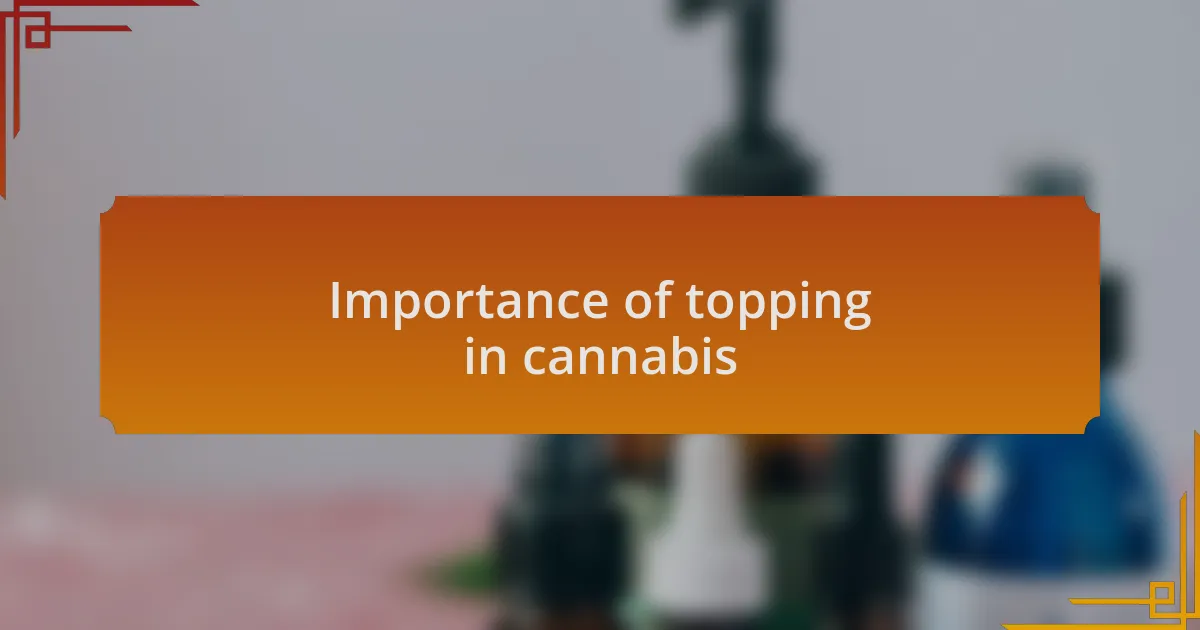
Importance of topping in cannabis
Topping is important for fostering a more compact, bushy structure in cannabis plants. From my experience, this encourages a more abundant canopy, allowing light to reach more leaves and ultimately increasing the number of colas. I remember one run where I topped my plants early, and the result was a significantly higher yield compared to those left untouched.
One aspect I find particularly rewarding about topping is its effect on plant health. When I implemented this technique, my plants thrived with improved air circulation between leaves, reducing the risk of mold and pests. Have you ever seen how a plant responds to being pruned? It’s almost as if they know the care provided allows them to focus on producing denser, more potent buds.
Moreover, topping teaches us about patience and timing in cultivation. I recall a time when I eagerly topped too soon, and although the plants recovered, the delay in building their strength taught me a valuable lesson. This process is not just about cutting; it’s a journey of understanding plant physiology and enhancing our role as cultivators. Wouldn’t you agree that each decision has a ripple effect on the plant’s life cycle?
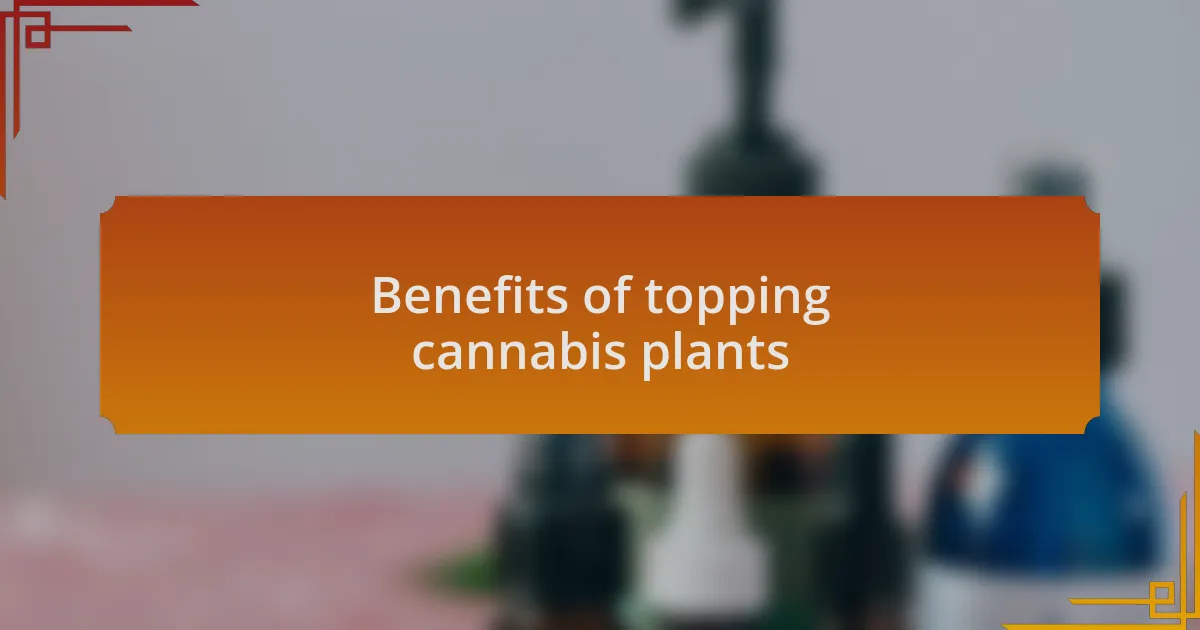
Benefits of topping cannabis plants
When I decided to top my cannabis plants, it felt like unlocking a hidden potential. Instead of just one main stem, I ended up with multiple tops that thrived in the light. It’s like watching a plant bloom after giving it a little nudge; the transformation is truly gratifying. Have you ever felt that rush when you see your plants respond positively to your care?
The real benefit of topping, in my opinion, lies in the more even distribution of nutrients. For instance, after topping, I noticed my plants developed a robust lateral growth that ensured every cola received its fair share. This balanced growth allows for each bud to develop fully, ultimately enhancing both size and potency. I still remember the thrill of harvesting those densely packed buds, each one a testament to the technique.
Also, topping can lead to a more manageable plant size, which I found invaluable in my smaller grow space. One season, I had plants growing uncontrollably tall; after topping, I achieved a perfect balance of height and bushiness. Do you think controlling plant size can make a significant difference in terms of space optimization and light exposure? I certainly believe so, as it enabled me to maximize my yield without sacrificing quality.
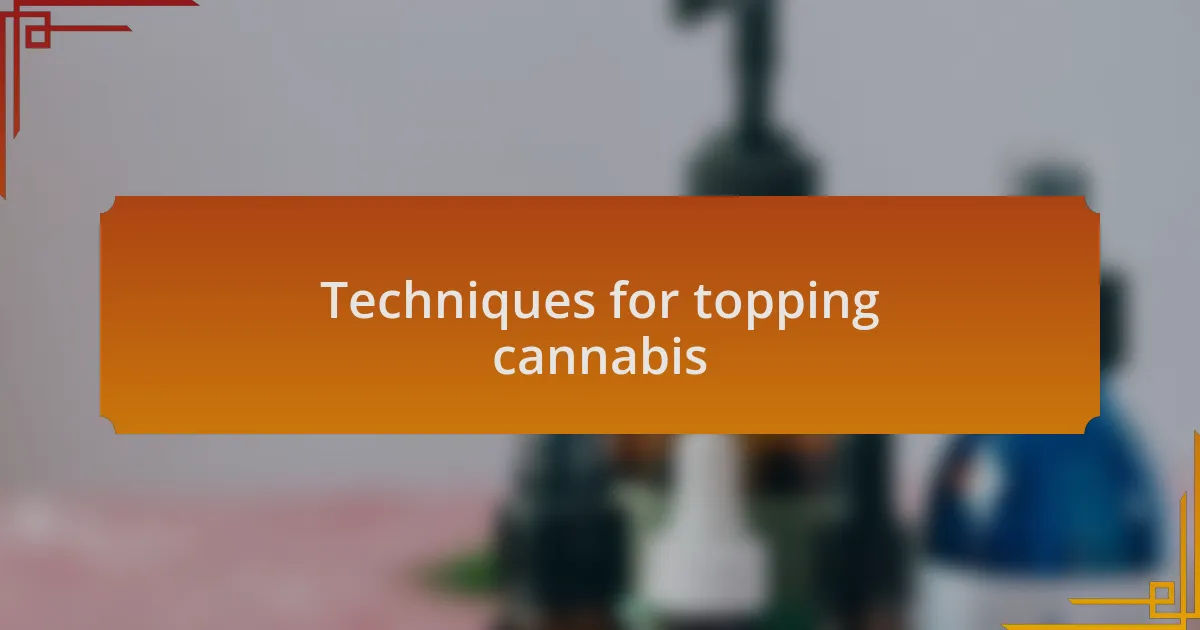
Techniques for topping cannabis
When it comes to topping cannabis, the timing plays a crucial role. I’ve found that topping at the right moment, just when plants have developed a few nodes, encourages a strong recovery and stimulates new growth. It’s like guiding a young plant in the right direction; I remember the thrill of watching new sprouts emerge as if they were thanking me for the prompt.
There’s also the technique itself, which can vary slightly based on personal preference. In my experience, I prefer using sharp, clean scissors to ensure a smooth cut. This way, I minimize stress on the plant. Have you ever made a cut that felt so right? That precise snip can feel almost satisfying, knowing you’re helping your plant flourish.
I can’t stress enough the importance of post-topping care. After the cut, I typically pamper my plants with extra attention, including optimal light and nutrients. This nurturing period is where the magic happens; witnessing those new branches start stretching toward the light provides an incredible sense of accomplishment. Have you experienced that moment when all your effort pays off? For me, it reiterates that every step in the process truly matters.
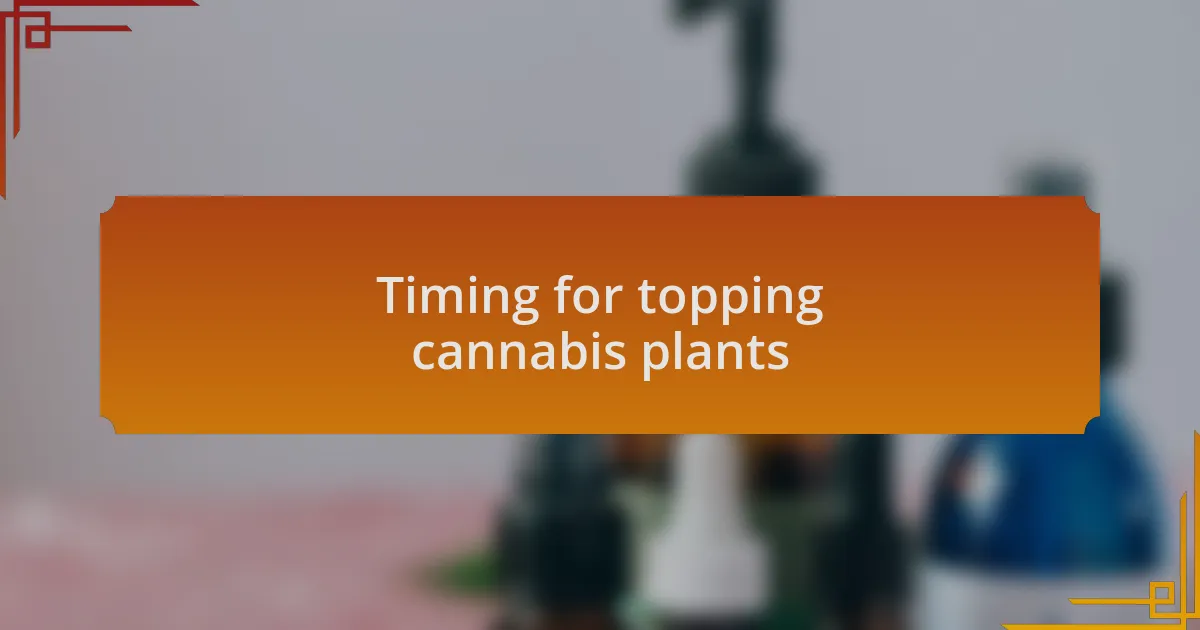
Timing for topping cannabis plants
Timing is essential when topping cannabis plants. I usually wait until the plants have developed at least three to five nodes. This stage indicates that they are robust enough to heal and adapt to the change. Have you ever felt that moment of anticipation when you know it’s time to make your move? It’s a mix of excitement and responsibility, knowing that your decision could significantly influence their growth trajectory.
In my experience, topping too early can lead to stunted growth, a lesson I learned the hard way. I vividly remember a cultivation session where my impatience cost me; the plants didn’t thrive as well as they could have. It made me appreciate the idea that patience truly pays off. Does that resonate with your journey? The right timing feels almost like tuning into the plants’ rhythm, allowing them to shine.
A second topping can sometimes be beneficial, usually around a week or two after the first. As I’ve noticed, giving your plants that extra time enables them to become more established. Each time I top, it’s as if I’m sculpting a beautiful work of art. Can you feel that creative energy? That blend of timing and technique transforms your plants into something more than just greenery; they become a testament to your care and expertise.

My personal topping experiences
When it comes to my topping experiences, I’ve discovered that technique plays a crucial role. I distinctly remember the first time I attempted to top a plant; I was nervous as I made the cut, almost like performing surgery. I hesitated, but the moment I saw two new shoots emerge, that rush of satisfaction was unforgettable. It was a reminder that sometimes, risks lead to rewarding outcomes.
I also learned that topping is not just about cutting; it’s about nurturing. After a successful topping session, I paid close attention to my plants’ responses. I was amazed by how they seemed to thrive; those vibrant green leaves unfurling felt like validation of my efforts. Have you ever noticed how plants react positively to your care? Each time I see that growth, it reaffirms my commitment to this craft.
Reflecting on my experiences, I’ve realized that topping has become a blend of art and science. Each new technique I try feels like adding another stroke to my canvas. I recently experimented with staggered topping on a couple of plants, and the results were fascinating. Can you relate to the thrill of trying something new and watching how your plants respond? It’s moments like these that remind me why I’m so passionate about cultivating cannabis.
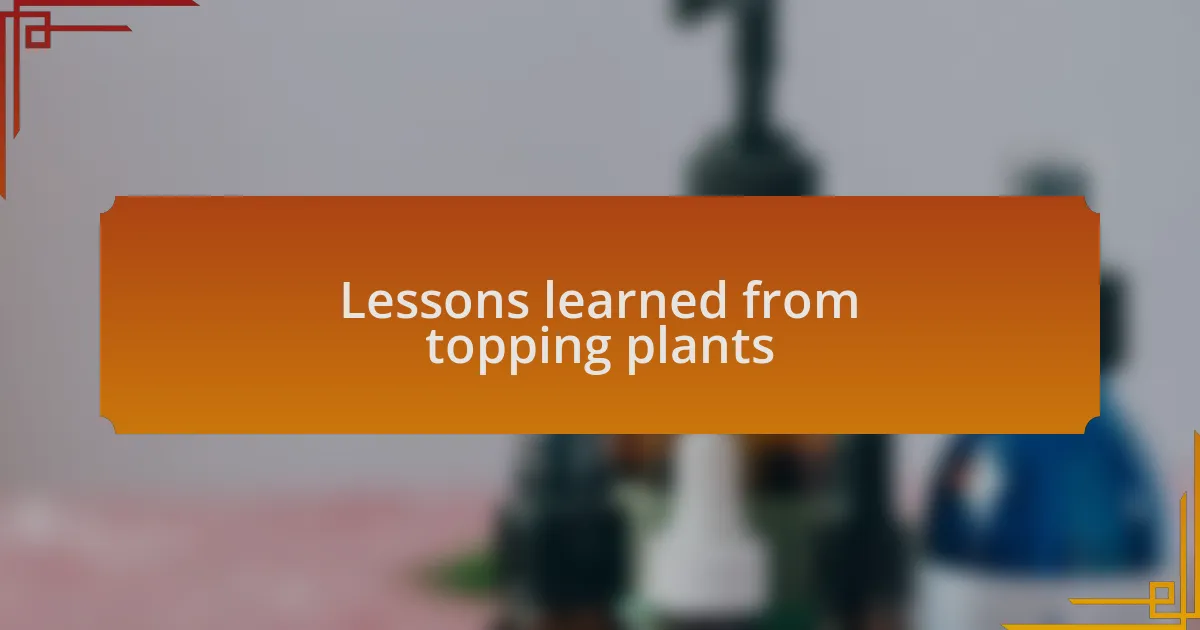
Lessons learned from topping plants
Topping plants has taught me the importance of patience in the growth process. During one of my topping sessions, I rushed the recovery time, eager to see immediate results. I was disappointed when the new growth was stunted, which made me realize that giving plants time to heal is just as vital as the cut itself. Have you ever been too eager to see results? Sometimes, the waiting makes all the difference.
In another instance, I decided to experiment with the timing of my toppings. Initially, I thought doing it too early would stunt growth, but I was pleasantly surprised by how well my plants responded when topped during the early vegetative stage. I learned that understanding the plant’s growth phases deepens my relationship with them. There’s a certain joy in figuring out what each plant needs—doesn’t it feel rewarding to witness their unique development?
What stands out to me most is that topping isn’t merely a technique; it’s a dialogue with nature. I remember observing how one plant seemed almost grateful after a well-timed topping; it exploded with new growth. This connection has brought a deeper appreciation for the entire cultivation journey. Have you felt that bond develop while tending to your plants? It’s those moments of clarity that inspire me to continue exploring and learning.